The Eighteenth International Lahti Sibelius Festival coincided with the centenary year of Finland’s political independence. In a previous year forty percent of tickets were sold to non-Finnish patrons, so its claim of international status is well justified. As usual concert tickets and hotel accommodation had been arranged at a special price for Sibelius One members. The lavishly illustrated and informative Festival book, designed in a similar format to previous years, was available from the Festival shop.
On 30 August 2017, our members arrived at the Festival from England, Wales, Germany, Netherlands, USA, Singapore and Australia. Over five days there were seven concerts at three venues. The Lahti Symphony Orchestra provided three concerts and another was by the Gothenburg Symphony Orchestra. Pre-concert talks were given in Finnish and English. There was also a song recital, a piano recital, ballet scenes accompanying a pared down version of the Violin Concerto, and a supplementary piano recital at Ainola. Sibelius One members enjoyed meals and excursions together and attended our AGM.
Before the first Lahti Symphony Orchestra concert, music journalist and lecturer Terry Barfoot provided an English-language but incomplete pre-concert talk. He immediately dispensed with the poetic part-songs and reserved his entire narrative for the epic Kullervo and its remarkable background, achievement and history. He projected a photo of the gaunt looking ninety-year-old composer that sometimes accompanies programme notes for Kullervo. But then he pointedly replaced it with a more appropriate image of the young master barely beyond his youth. He then showed us an image of the mythical Kullervo as imagined by Gallen-Kallela (but wrongly attributing it to Sibelius’s brother-in-law Eero Järnefelt).
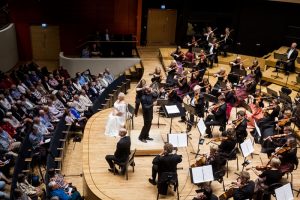
Then numerous members of the YL Male Voice Choir gradually filed onto the stage of the Sibelius Hall, filling its width in two rows. Taking the pitch for each song with the aid of a tuning fork, they sang a bracket of a cappella songs, Veljeni vierailla mailla (My Brothers Abroad), JS 217, Rakastava (The Beloved), Op. 14 and the Six Part-Songs, Op. 18, revealing a less familiar side of Sibelius’s poetic genius. After an early interval the Choir was joined by the Lahti Symphony Orchestra and the two soloists, soprano Johanna Rusanen-Kartano and her brother, baritone Ville Rusanen. This time the YL Choir members filed in behind the orchestra. The siblings matched each other artistically as they related the troubled encounter between mythological brother and sister. The choir sang darkly with full force when needed. Audience members were barely able to resist thunderous applause at the completion of the purely orchestral Kullervo Goes to War, such was its dramatic impact. The echoes of those final bars in Kullervo’s Death resonated in our memories for several minutes.
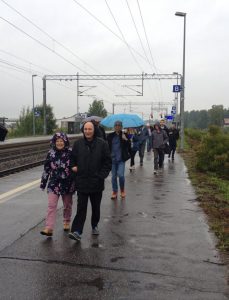
Thursday’s visit via rail to Ainola was enjoyed by a dozen or so Sibelius One members. As we left the railway platform, umbrellas were unfolded for the final twenty-minute walk to our beloved destination. We spent more time inside the coffee shop designed by Sibelius’s grandson than we did out in the garden. Inside, the villa was rather crowded and a young lady gave us a concise description of life and various changes to the property over sixty years. She recalled that the lady of the house had observed the villa was designed by a bachelor who was not aware of a young family’s needs. The master of the house had revealed to other residents his particular mood each day by his choice of ashtray.
The original action mechanism of Ainola’s Steinway piano had been removed recently because it had worn out. Pianist Juhani Lagerspetz introduced a short recital by relating the home keys of his music choices to the green colour of the tiles adorning the stove. So, both Lied, Op. 97/2, and the Sonata, Op. 12, are in the key of F major. Members were disappointed with the new sounds of the action mechanism emanating from the heritage furniture. Lagerspetz struggled with the tricky rhythms of the Sonata.
We then walked beside Lake Tuusula to the Art Museum of Järvenpää where there was an exhibition on the life and times of Elisabeth Järnefelt and her artistically gifted family. The curator was summoned to serve as our excellent guide. The exhibition was a sequel to a previous one relating to Elisabeth’s daughter Aino, who became Sibelius’s wife. Elisabeth Järnefelt was from a noble and artistically gifted Russian family. Her husband, Lieutenant General Alexander Järnefelt, had risen to his senior military rank through his work as head of topography. Alexander’s mother language was Swedish and Elisabeth’s was Russian. They became leading Finnish patriots and insisted on speaking the Finnish language. Alexander was away at work a great deal. Their marriage was not particularly happy although they produced several gifted offspring including painters, and musicians. Alexander became a Finnish Senator and Governor of Vaasa. Elisabeth became known as the mother of Finnish art and culture.
Friday afternoon’s very satisfying piano recital was by Juhani Lagerspetz in the Kalevi Aho Hall of the Lahti Music Institute. He repeated the two F major selections we heard at Ainola, but this time played more fluently. Björken (The Birch) from Op. 75 was followed by the thoughtful Rêverie, Op. 58/1, the robust Kyllikki, Op. 41, Five Characteristic Impressions, Op. 103 and Five Esquisses, Op. 114, which are in the composer’s most advanced pantheistic piano style. The encore was the early romantic Impromptu, Op. 5/5.
Thursday evening’s pre-concert talk between compère Ville Komppa and conductor Dima Slobodeniouk was uninformative beyond the conductor’s background and public persona. Slobodeniouk moved from Russia to Finland as a child and after studying music in Moscow continued to do so in Helsinki. He became principal conductor of the Lahti Symphony Orchestra last year, the first non-Finnish born musician to do so.
That perfectly formed tone poem The Oceanides opened that evening’s programme in style. The large orchestra including two harps uses a greater range of instrumental colours than any Sibelius symphony. Before the early interval the soloist, soprano Anu Komsi, sang three challenging songs with amazing control. At least two were the sort of songs Sibelius would have had in mind for the dramatic soprano Aino Ackté rather than his favourite lyric soprano Ida Ekman. Of the three, only Höstkväll (Autumn Evening) had been orchestrated by the composer, although the arrangement used here was by Sakari Oramo, as was that used for Jubal. Ernest Pingoud’s arrangement of En slända (A Dragonfly) was chosen. We were not surprised to hear Komsi’s brilliant interpretation of Luonnotar after negotiating the trills in En slända. We were thrilled by a wonderful interpretation of the Lemminkäinen tone poems, although some of us would have preferred to hear The Swan of Tuonela ordered before Lemminkäinen in Tuonela.
The Friday orchestral concert was preceded by a disastrous pre-concert talk from music journalist Ville Komppa and Gothenburg Symphony Orchestra conductor, Santtu-Matias Rouvali. The very late arrival of Rouvali, more than half way through the allotted time, forced Komppa to improvise with increasing desperation; he told us that the absent Rouvali was originally a boy from Lahti. Eventually Rouvali arrived and then gabbled to us in Finnish before he was reminded that we were an English-language audience. A few minutes later he rushed away, never to return, saying he had to organize free tickets for his parents. The conductor’s flippancy and lack of respect for the audience earned him our nickname ‘The Brat’. We suppose he had more important issues on his mind in preparing for the concert.
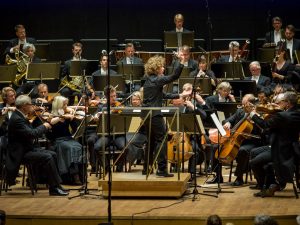
The Gothenburg Symphony Orchestra has a long history involving Sibelius, who conducted it several times early last century when his friend Wilhelm Stenhammar was in charge. The orchestra was generously supplied with brass instruments for the ballade Skogsrået (The Wood-Nymph), Op. 15. As a conductor, Rouvali operated like a delicate ballet dancer. Those attending the pre-concert talk were warned that at the completion of The Wood-Nymph there would be a drum-roll replacing an opportunity to applaud, and En saga would begin without a pause. One or two instrumentalists moved aside between items, and so it happened. The effect of the closing bars of the one followed by the opening bars of the other were totally lost. At least the pre-concert talk audience was warned of this bizarre decision. Late arrivals, perhaps through no fault of their own, would have missed the whole of the first half. Who knows how the broadcasters and radio audience would have responded? Matters improved after interval with a satisfying performance of the magnigficent Symphony No. 5 followed by a glorious sunset overlooking Lake Vesijärvi.
During the interval of the Gothenburg Symphony Orchestra concert, the Sibelius Society of Finland provided members of other Sibelius Societies, including ours, with coffee and chocolate cake in an adjacent meeting room. We were told that this year represents the golden jubilee of the Sibelius Monument in Helsinki, and a forthcoming exhibition to celebrate the popular tourist site would soon take place. Early plans are already in place for the 2020 Sibelius Violin Competition. A major announcement was that in November 2017 the music of Sibelius is to be promoted to more than fifty Chinese orchestras by the Sibelius Society of Finland, while pianist Folke Gräsbeck will be in China to conduct masterclasses.
Mezzo-soprano Monica Groop’s song recital on the Saturday afternoon with accompanist Ilmo Ranta was held in the Felix Krohn Hall, a venue at the other end of the city centre and usually overlooked since the Sibelius Hall opened seventeen years ago. With her strong voice and commanding presence she won the battle against the unsympathetic acoustic there. Her repertoire covered the three decades of creativity from the charming Serenade (Serenad) of 1888 to the tongue-in-cheek cabaret-styled Små flickorna (Small Girls) of 1920. The selections were settings of four languages: Swedish, Finnish German and English. She avoided the popular Op. 36 group. The core of her recital consisted of the complete Op. 57 settings of Ernst Josephson. That opus group was composed in 1909 during the composer’s so called expressionist period. The groupings of songs were punctuated by Mr Ranta with piano solos from Op. 58 and elsewhere.
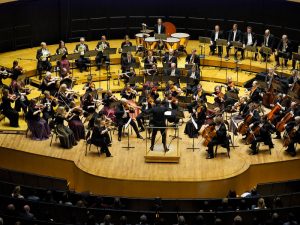
The final orchestral concert early on Saturday evening consisted of repertoire in keeping with the theme of celebrating Finland’s centenary. No music by Sibelius is more blatantly patriotic than the Press Celebrations Music which filled the first half. Once again Terry Barfoot was our pre-concert speaker and he referred to Finland’s political situation in 1899, during the time of the Press Celebrations Music. He did not refer to its obvious connection with the Scènes historiques Suite No. 1, Op. 25. Symphony No. 2 is claimed to be an intentionally patriotic work despite the composer’s denial and all the evidence to support him. It was played with great power, precision and passion. Because the Press Celebrations Music concluded with a preliminary version of Finlandia the normal encore was replaced with the next most obvious alternative, Valse triste, which was played very delicately.
The Festival was an ideal opportunity for Sibelius One to hold its AGM as so many members had arrived in the one place from the four corners of the globe. Hesan kamari, the basement room at Ainola, was unavailable this time owing to restoration work. Instead we were allocated a meeting room inside the Sibelius Hall in Lahti. Membership has grown slightly and finances are modest but sound. The imminent release a CD of songs sung by soprano Hedvig Paulig with accompanist Folke Gräsbeck was discussed, the committee members were reappointed unanimously and a constructive discussion was boosted by relatively new members. Click here for minutes of the 2017 AGM (members only).
‘Sibelius on a Sunday Morning’ began in the Sibelius Hall with pianist Heini Kärkkäinen and the suite The Trees, Op. 75. The entertainment’s title, On a String, applied more obviously to the remainder of the programme, which was a ballet-enhanced version of the Violin Concerto with soloist Minna Pensola, while Kärkkäinen played the composer’s piano arrangement of the orchestral part. On the blacked-out stage the violinist began playing under directed floodlight and was alternately followed by one or both of the ballet dancers, Kaari Martin and Minna Tervamäki wearing flamenco dresses. They danced individually and sometimes concurrently to their own choreography as the Concerto progressed.
We have not yet been informed what to expect at next year’s Festival. Most of the orchestral selections this year were regular offerings. Supposing that the neglected Scènes historiques Suite No. 2 and the cantata Tulen synty (The Origin of Fire), Op 32, were to be programmed next time, distant Sibelius One members could be more strongly tempted to return despite enduring long tedious flights on the way.
Geoff Hayes
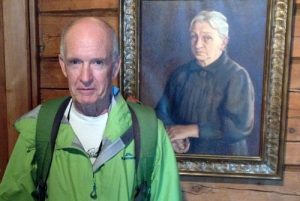
Geoff Hayes was born in Melbourne, Australia, in 1942. He studied at Melbourne University and worked at the Australian Bureau of Statistics from 1966 until 1995. He is known for his extensive knowledge of Sibelius’s music and he has been a programmer and presenter at the community radio station 3MBS in Melbourne since 1986.